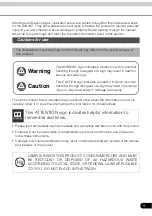
Link XP L2102/L2104 Receiver Instruction Manual Issue 1 - October 2003 Page 24 of 48
Link Research Ltd. 23/24 Watford Metro Centre, Dwight Road, Watford, Hertfordshire, WD18 9XA, England. Tel: +44 (0) 1923 200 900
Registered in London No. 2074604
Web:
www.linkres.co.uk Fax: +44 (0) 1923 241 357
L2102 & L2104 Receiver
Instruction Manual
•
Keep antennae in the clear especially the transmit antenna. The human body is 80%
water and is a good RF attenuator so the antenna should be above head height to
be most effective. Although COFDM relies on reflections, the receive antenna
needs enough clear space to be able to “see” the different radiation paths.
•
Test a number of different locations. On the day of the live transmission, the RF
characteristics of the environment may have changed significantly e.g. a stadium
with a capacity crowd is very different to when it is empty.
•
Use only good quality cables and keep them as short as possible so that maximum
signal is available.
•
For Diversity and Dual Diversity installations, pairs of antennas should be spaced
20cm apart for optimum performance.
It is most likely that LinkXP will be used in temporary locations so jubilee clips, cable tie
wraps, gaffer tape etc are likely to be used. So long as the antennae are held firmly and
vertically, they should work well.
2.1.5
A some practical examples
Example 1
The requirement was for coverage of a rugby final in a national stadium. The Director
wanted the following:
•
Coverage of the pitch for all the match action and the pre-match entertainment
•
Pictures of the teams in the changing rooms before the match, during the interval
and after the game
•
Pictures of the teams leaving the dressing rooms and running down the tunnel onto
the pitch. (The tunnel was about 100 metres long and underneath the main stand).
•
Touchline cover of the match and close-ups of interesting incidents
•
Close-ups of the celebrities in the main stand
•
On pitch post match celebrations and interviews
It was decided to use 3 antennae to give coverage of the event. No permanent cabling was
available so cables had to be run in specially in a very limited time. Antennae were
mounted vertically on microphone stands about 1.7metres above ground level giving good
horizontal omni directional coverage. Locations of the antennae were as follows:
•
One near the corner flag
•
One near the tunnel entrance adjacent to the pitch
•
One at the end of the tunnel near the changing rooms















































